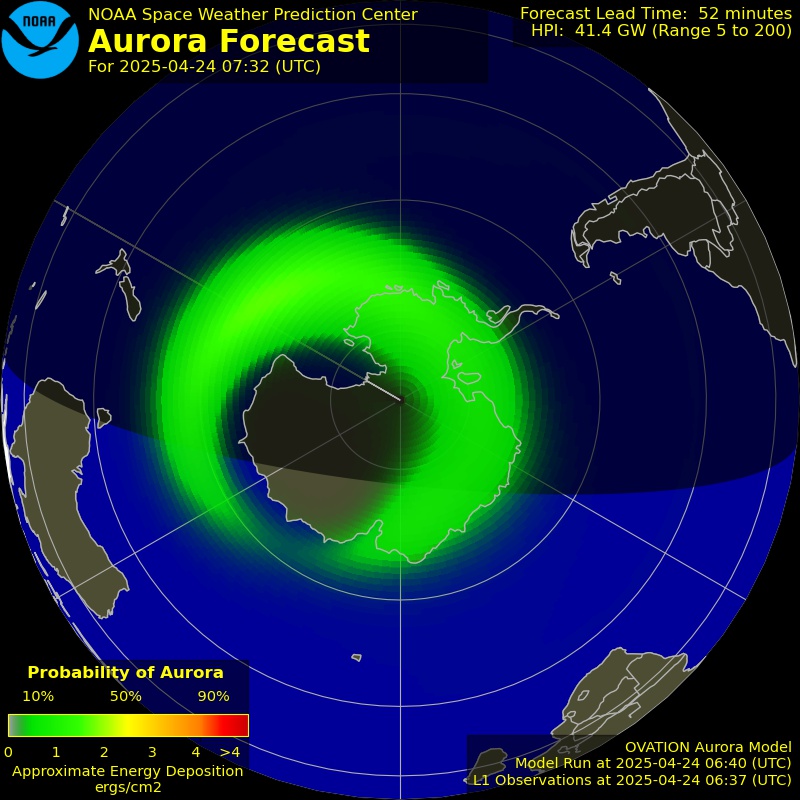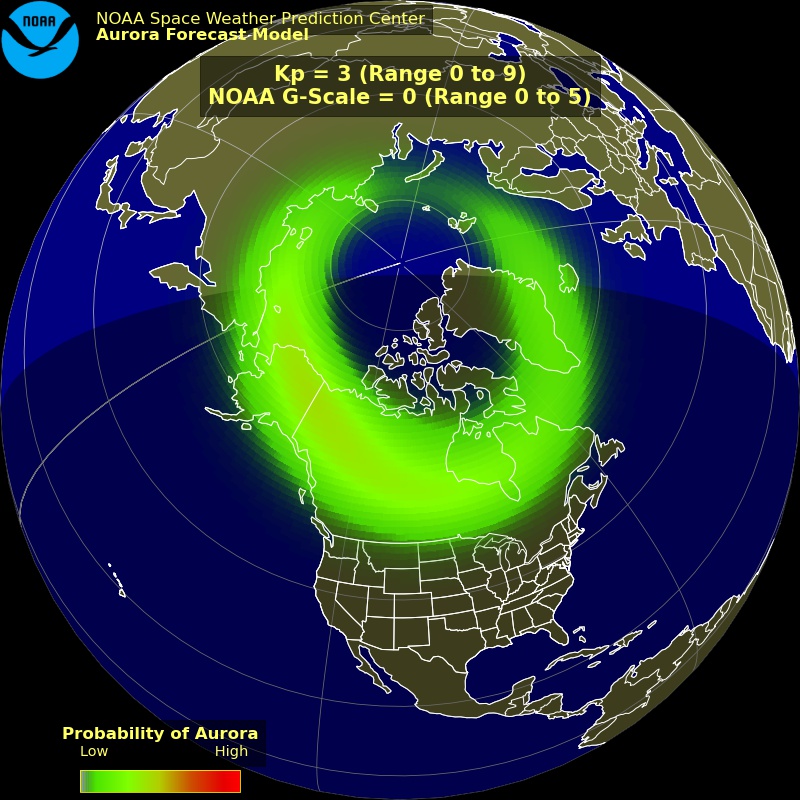Noaa Aurora Forecast: Your Ultimate Guide To Spotting The Northern Lights
Alright folks, let's get straight to the point. If you've ever found yourself gazing up at the night sky in awe, dreaming of witnessing the mesmerizing dance of the aurora borealis, then you're in the right place. The NOAA Aurora Forecast is your ticket to predicting when and where you can catch this breathtaking phenomenon. So grab your favorite drink, settle in, and let's dive into how you can harness the power of NOAA's forecasts to plan your ultimate aurora adventure.
Now, you might be wondering, "What exactly is the NOAA Aurora Forecast?" Well, my friend, it's a tool that helps you track the aurora borealis, also known as the Northern Lights. It's like having a personal weatherman for the stars, giving you updates on when and where the auroras are likely to appear. With this info, you can plan your trips to the best viewing spots and ensure you don't miss out on the show of a lifetime.
Before we jump into the nitty-gritty details, let's set the stage. The aurora borealis is one of nature's most spectacular displays, and witnessing it is an experience that stays with you forever. The NOAA Aurora Forecast makes it easier than ever to catch this natural light show. So, without further ado, let's get started on your journey to becoming an aurora-hunting pro.
Read also:Michael Consuelos Partner The Journey And Insights You Need To Know
Understanding the Basics of the NOAA Aurora Forecast
What is NOAA Aurora Forecast?
So, what exactly is the NOAA Aurora Forecast? Simply put, it's a service provided by the National Oceanic and Atmospheric Administration (NOAA) that predicts the occurrence of auroras. The NOAA uses advanced satellite data and scientific models to forecast geomagnetic activity, which directly affects the visibility of the aurora borealis. This forecast is crucial for anyone planning to see the Northern Lights because it helps you determine the best times and locations for optimal viewing.
For instance, if you're planning a trip to Iceland or Norway, you can use the NOAA Aurora Forecast to ensure you're there during peak aurora activity. It's like having a crystal ball that tells you when the skies will light up with vibrant colors. And trust me, knowing this info beforehand can make all the difference in your aurora-hunting adventure.
Why is the NOAA Aurora Forecast Important?
Here's the deal: auroras are unpredictable. One moment they're lighting up the sky, and the next, they're gone. That's where the NOAA Aurora Forecast comes in. By providing real-time updates and predictions, it helps you maximize your chances of seeing the Northern Lights. Whether you're a seasoned traveler or a first-time adventurer, this tool is a game-changer.
Think of it this way: would you go on a road trip without checking the weather? Probably not, right? The same goes for aurora hunting. The NOAA Aurora Forecast is your weather report for the auroras, and it's essential for planning your trip. Plus, it adds an element of excitement to the whole experience, as you eagerly wait for the forecast to confirm your plans.
How Does the NOAA Aurora Forecast Work?
Gathering Data from Satellites
Alright, let's talk about the science behind the NOAA Aurora Forecast. The NOAA relies on a network of satellites to gather data about solar activity. These satellites monitor the sun's behavior, tracking solar flares and coronal mass ejections (CMEs). When these events occur, they send charged particles hurtling towards Earth, which interact with our planet's magnetic field to create auroras.
By analyzing this data, the NOAA can predict when and where auroras are likely to occur. It's a complex process, but the end result is a reliable forecast that helps you plan your aurora-hunting trips. So, the next time you're out there gazing at the Northern Lights, remember that it's all thanks to the hard work of scientists and the technology that powers the NOAA Aurora Forecast.
Read also:Sophierain Erome The Rising Star In The Digital World
Predicting Geomagnetic Activity
Now, let's dive a little deeper into how the NOAA predicts geomagnetic activity. The key lies in understanding the Kp index, which measures the intensity of geomagnetic storms. The higher the Kp index, the more likely it is that auroras will be visible at lower latitudes. The NOAA Aurora Forecast uses this index to provide detailed predictions about auroral activity.
For example, if the forecast shows a Kp index of 5 or higher, it means there's a good chance of seeing auroras in regions that are typically outside the auroral oval. This is great news for those who live in areas where auroras are rare, as it gives them a chance to experience this natural wonder without traveling too far. And with the NOAA Aurora Forecast, you'll always know when to keep an eye on the skies.
Key Features of the NOAA Aurora Forecast
Real-Time Updates
One of the coolest features of the NOAA Aurora Forecast is its real-time updates. Unlike some other aurora prediction services, the NOAA provides up-to-the-minute information about auroral activity. This means you can stay informed about changes in the forecast and adjust your plans accordingly.
For instance, if the forecast initially predicts low auroral activity but then updates to show a sudden increase, you'll know it's time to grab your camera and head outside. Real-time updates are especially useful for those who live in areas where auroras are unpredictable, as they allow you to take advantage of unexpected opportunities.
Interactive Maps
Another awesome feature of the NOAA Aurora Forecast is its interactive maps. These maps show the current position of the auroral oval, which is the region around the poles where auroras are most likely to occur. By using these maps, you can pinpoint the best locations for viewing auroras based on your current location.
Imagine being able to see exactly where the auroras are dancing across the sky. With the NOAA's interactive maps, that's a reality. Whether you're planning a trip or just want to know if it's worth stepping outside, these maps are an invaluable resource for aurora enthusiasts everywhere.
Factors Affecting Aurora Visibility
Solar Activity
Let's talk about the biggest factor affecting aurora visibility: solar activity. As I mentioned earlier, solar flares and CMEs play a crucial role in creating auroras. When the sun is particularly active, it sends more charged particles towards Earth, increasing the likelihood of auroral displays. That's why the NOAA Aurora Forecast closely monitors solar activity to provide accurate predictions.
But here's the catch: solar activity isn't always consistent. There are periods of high activity followed by periods of calm. This is why it's important to keep an eye on the forecast, as it can help you identify the best times to see auroras. And if you're lucky enough to catch a period of high solar activity, you might just witness one of the most spectacular auroral displays of your life.
Weather Conditions
Alright, let's be real for a moment. Even if the NOAA Aurora Forecast predicts a fantastic auroral display, you won't see it if the weather doesn't cooperate. Cloudy skies, rain, and fog can all obscure your view of the Northern Lights. That's why it's important to consider weather conditions when planning your aurora-hunting trip.
Thankfully, the NOAA Aurora Forecast often includes weather data to help you make informed decisions. By combining auroral predictions with weather forecasts, you can increase your chances of finding clear skies and optimal viewing conditions. So, always check the weather before heading out, and don't be afraid to adjust your plans if necessary.
Planning Your Aurora Adventure
Choosing the Right Time
So, you've decided to embark on an aurora adventure. The first step is choosing the right time to go. The best time to see auroras is during the winter months, when the nights are longest and the skies are darkest. This gives you more opportunities to witness the Northern Lights in all their glory.
But timing isn't just about the season. It's also about the phase of the moon. A full moon can make it harder to see auroras, as its brightness can overpower the subtle glow of the lights. That's why it's often recommended to plan your trip during the new moon, when the skies are darkest and the auroras are most visible. And, of course, the NOAA Aurora Forecast can help you pinpoint the best dates for your trip.
Selecting the Best Location
Now that you know when to go, it's time to choose where to go. The best locations for viewing auroras are typically in the auroral oval, which spans regions like Alaska, Canada, Iceland, Norway, and Sweden. These areas offer some of the best opportunities to see the Northern Lights, thanks to their proximity to the poles.
But don't worry if you don't live near these regions. With the NOAA Aurora Forecast, you can find out when auroras might be visible in your area. Even if you're not in the auroral oval, a strong geomagnetic storm can bring the lights to lower latitudes, giving you a chance to experience this natural wonder without traveling too far.
Tips for Aurora Hunting
Essential Gear
Alright, let's talk gear. If you're serious about aurora hunting, there are a few essentials you'll want to bring along. First and foremost, you'll need a good camera with manual settings. This will allow you to capture the beauty of the auroras and create stunning photos to cherish forever.
In addition to a camera, you'll want to bring warm clothing, as aurora hunting often takes place in cold, remote locations. A tripod is also a must-have, as it helps stabilize your camera for long exposures. And don't forget a flashlight or headlamp, so you can see what you're doing without ruining your night vision.
Maximizing Your Experience
Finally, let's talk about how to maximize your aurora-hunting experience. The key is to be patient and persistent. Auroras can be unpredictable, so it's important to stay out for as long as possible to increase your chances of seeing them. And when they do appear, take a moment to appreciate the beauty of the moment.
Remember, the NOAA Aurora Forecast is just a tool to help you plan your trip. It can't guarantee that you'll see auroras, but it can certainly improve your odds. So, embrace the adventure, enjoy the journey, and most importantly, have fun. After all, the Northern Lights are one of nature's greatest gifts, and experiencing them is an experience you'll never forget.
Conclusion
Well, folks, that's a wrap on our ultimate guide to the NOAA Aurora Forecast. We've covered everything from the basics of how it works to tips for planning your aurora adventure. The NOAA Aurora Forecast is an invaluable resource for anyone looking to witness the breathtaking beauty of the Northern Lights.
So, what are you waiting for? Grab your gear, check the forecast, and get out there to experience one of nature's most spectacular displays. And don't forget to share your photos and stories with the world. Who knows, you might just inspire someone else to embark on their own aurora-hunting journey. Until next time, keep your eyes on the skies and your dreams set on the stars.
Table of Contents
- Understanding the Basics of the NOAA Aurora Forecast
- What is NOAA Aurora Forecast?
- Why is the NOAA Aurora Forecast Important?
- How Does the NOAA Aurora Forecast Work?
- Gathering Data from Satellites
- Predicting Geomagnetic Activity
- Key Features of the NOAA Aurora Forecast
- Real-Time Updates
- Interactive Maps
- Factors Affecting Aurora Visibility
- Solar Activity
- Weather Conditions
- Planning Your Aurora Adventure
- Choosing the Right Time
- Selecting the Best Location
- Tips for Aurora Hunting
- Essential Gear
- Maximizing Your Experience
Article Recommendations


